Surgical Safety Checklist Effectiveness
VerifiedAdded on 2020/04/13
|15
|4063
|31
AI Summary
This assignment examines research articles related to the impact of the WHO Surgical Safety Checklist on surgical procedures. The focus is on evaluating its effectiveness in improving operating room safety culture, reducing wound complications, and minimizing unplanned readmissions. The analysis considers both quantitative and qualitative evidence presented in the provided research papers.
Contribute Materials
Your contribution can guide someone’s learning journey. Share your
documents today.
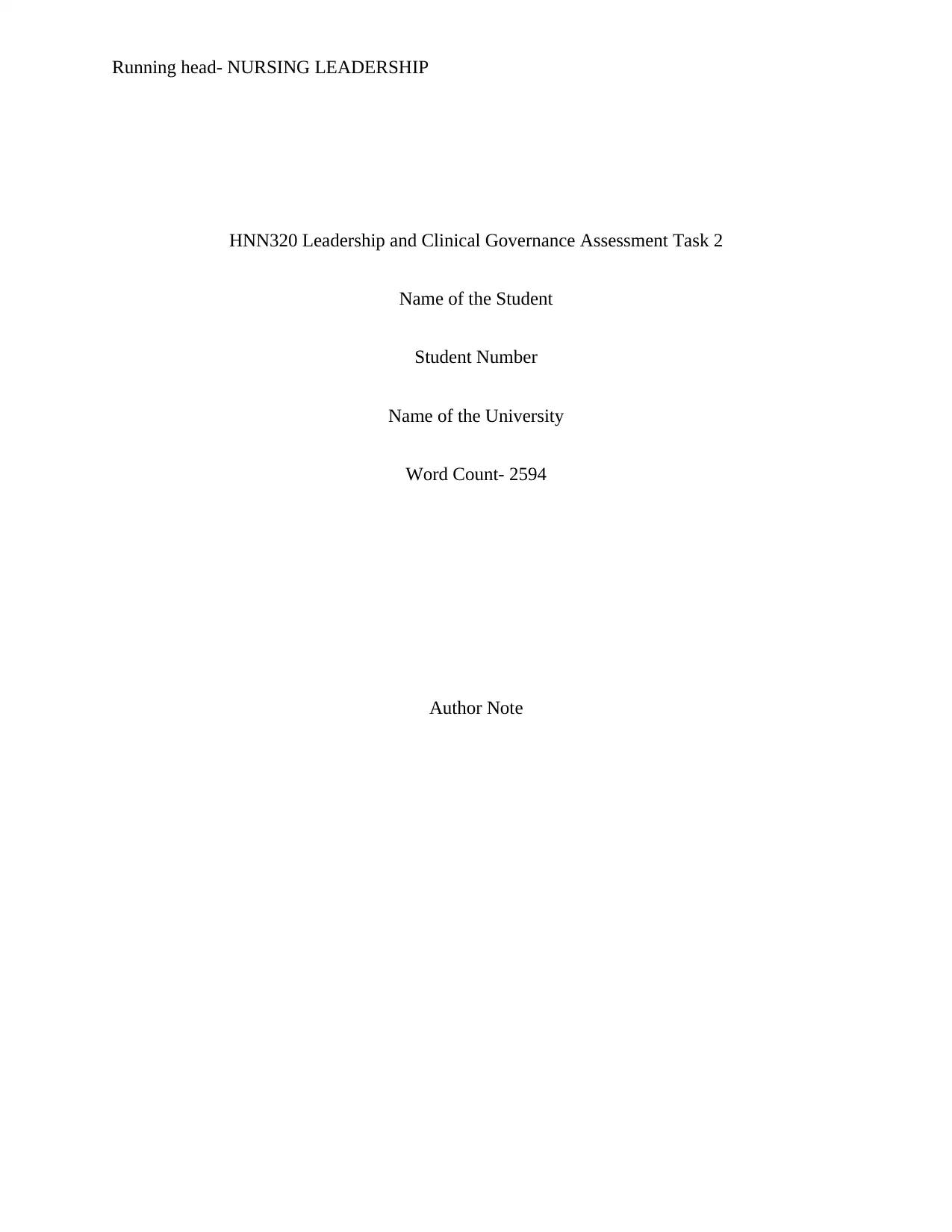
Running head- NURSING LEADERSHIP
HNN320 Leadership and Clinical Governance Assessment Task 2
Name of the Student
Student Number
Name of the University
Word Count- 2594
Author Note
HNN320 Leadership and Clinical Governance Assessment Task 2
Name of the Student
Student Number
Name of the University
Word Count- 2594
Author Note
Secure Best Marks with AI Grader
Need help grading? Try our AI Grader for instant feedback on your assignments.
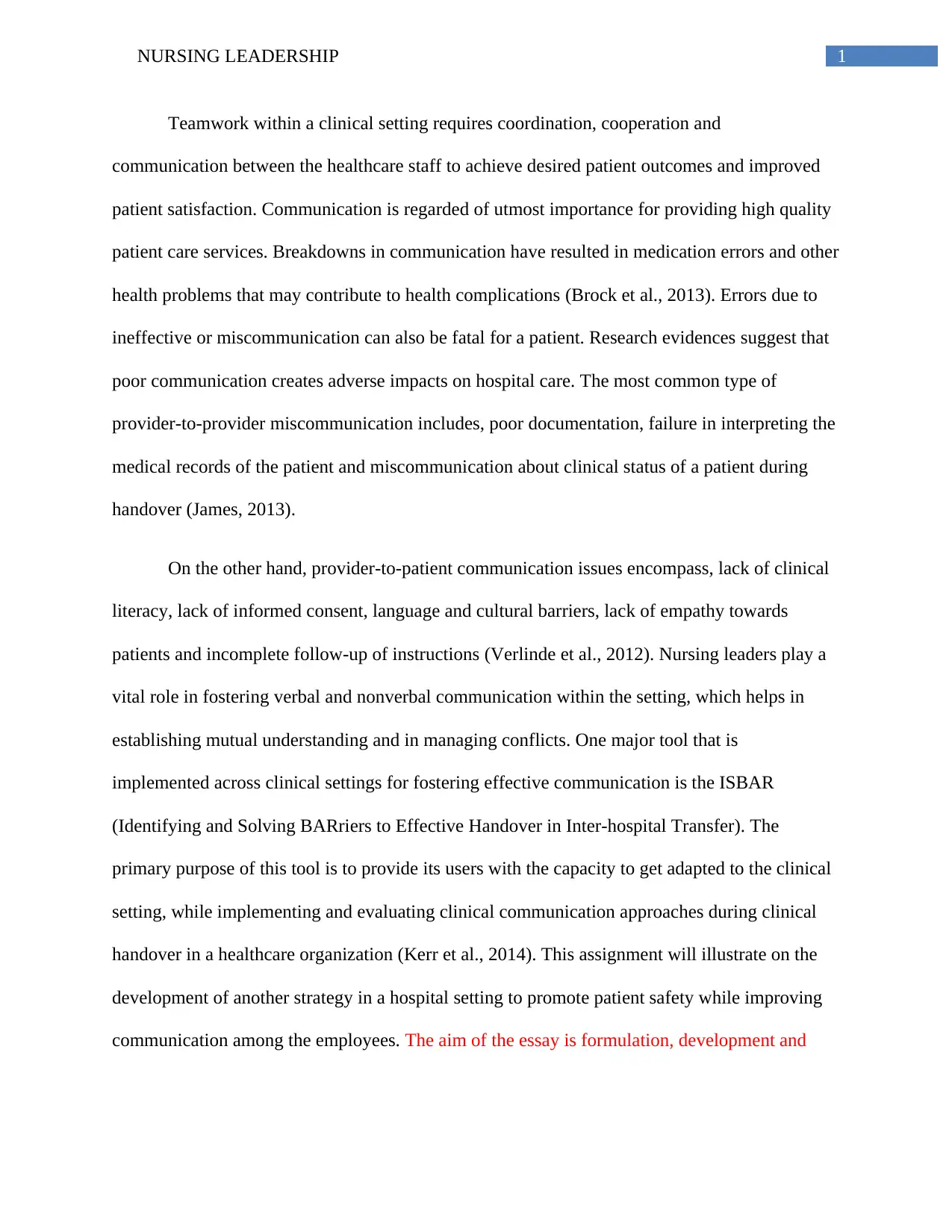
1NURSING LEADERSHIP
Teamwork within a clinical setting requires coordination, cooperation and
communication between the healthcare staff to achieve desired patient outcomes and improved
patient satisfaction. Communication is regarded of utmost importance for providing high quality
patient care services. Breakdowns in communication have resulted in medication errors and other
health problems that may contribute to health complications (Brock et al., 2013). Errors due to
ineffective or miscommunication can also be fatal for a patient. Research evidences suggest that
poor communication creates adverse impacts on hospital care. The most common type of
provider-to-provider miscommunication includes, poor documentation, failure in interpreting the
medical records of the patient and miscommunication about clinical status of a patient during
handover (James, 2013).
On the other hand, provider-to-patient communication issues encompass, lack of clinical
literacy, lack of informed consent, language and cultural barriers, lack of empathy towards
patients and incomplete follow-up of instructions (Verlinde et al., 2012). Nursing leaders play a
vital role in fostering verbal and nonverbal communication within the setting, which helps in
establishing mutual understanding and in managing conflicts. One major tool that is
implemented across clinical settings for fostering effective communication is the ISBAR
(Identifying and Solving BARriers to Effective Handover in Inter-hospital Transfer). The
primary purpose of this tool is to provide its users with the capacity to get adapted to the clinical
setting, while implementing and evaluating clinical communication approaches during clinical
handover in a healthcare organization (Kerr et al., 2014). This assignment will illustrate on the
development of another strategy in a hospital setting to promote patient safety while improving
communication among the employees. The aim of the essay is formulation, development and
Teamwork within a clinical setting requires coordination, cooperation and
communication between the healthcare staff to achieve desired patient outcomes and improved
patient satisfaction. Communication is regarded of utmost importance for providing high quality
patient care services. Breakdowns in communication have resulted in medication errors and other
health problems that may contribute to health complications (Brock et al., 2013). Errors due to
ineffective or miscommunication can also be fatal for a patient. Research evidences suggest that
poor communication creates adverse impacts on hospital care. The most common type of
provider-to-provider miscommunication includes, poor documentation, failure in interpreting the
medical records of the patient and miscommunication about clinical status of a patient during
handover (James, 2013).
On the other hand, provider-to-patient communication issues encompass, lack of clinical
literacy, lack of informed consent, language and cultural barriers, lack of empathy towards
patients and incomplete follow-up of instructions (Verlinde et al., 2012). Nursing leaders play a
vital role in fostering verbal and nonverbal communication within the setting, which helps in
establishing mutual understanding and in managing conflicts. One major tool that is
implemented across clinical settings for fostering effective communication is the ISBAR
(Identifying and Solving BARriers to Effective Handover in Inter-hospital Transfer). The
primary purpose of this tool is to provide its users with the capacity to get adapted to the clinical
setting, while implementing and evaluating clinical communication approaches during clinical
handover in a healthcare organization (Kerr et al., 2014). This assignment will illustrate on the
development of another strategy in a hospital setting to promote patient safety while improving
communication among the employees. The aim of the essay is formulation, development and
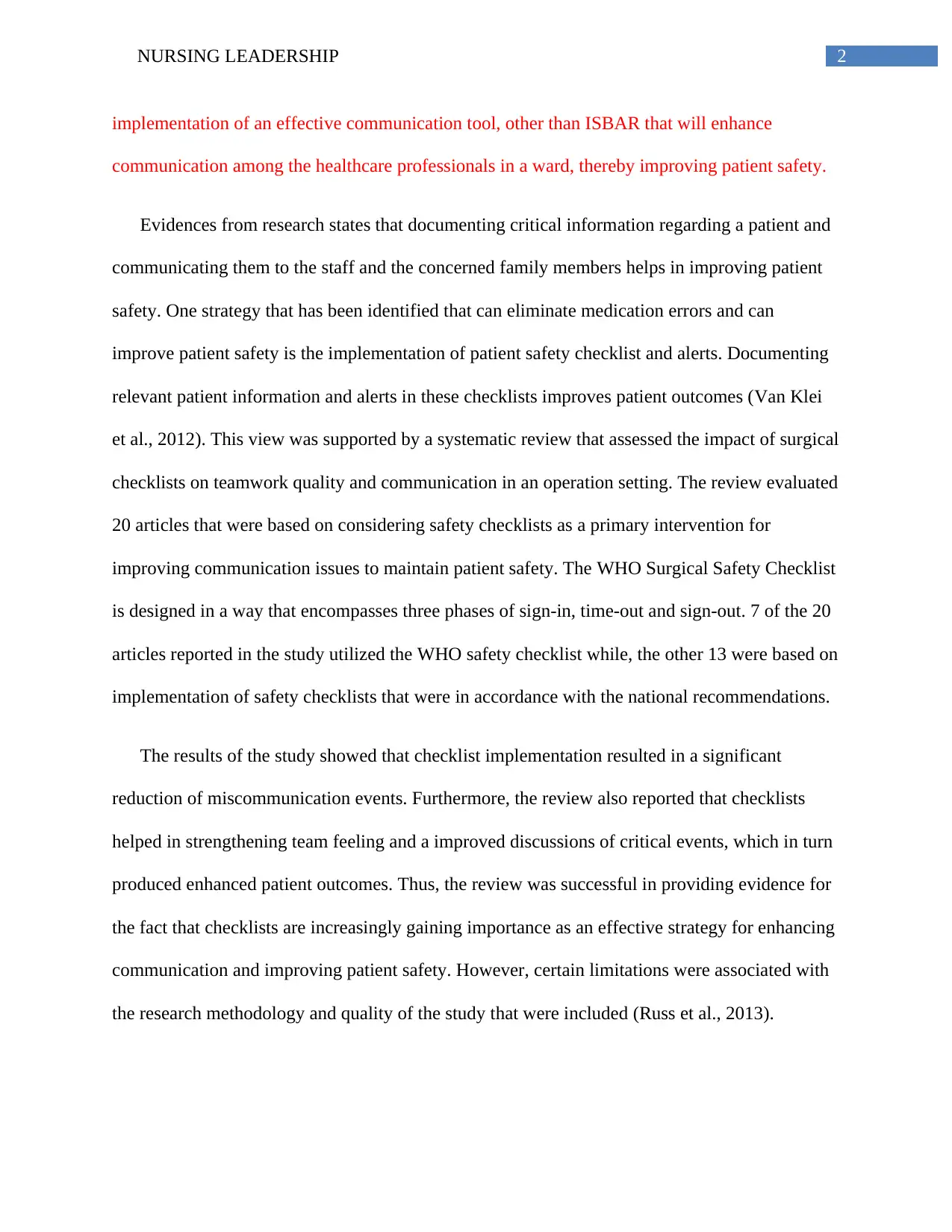
2NURSING LEADERSHIP
implementation of an effective communication tool, other than ISBAR that will enhance
communication among the healthcare professionals in a ward, thereby improving patient safety.
Evidences from research states that documenting critical information regarding a patient and
communicating them to the staff and the concerned family members helps in improving patient
safety. One strategy that has been identified that can eliminate medication errors and can
improve patient safety is the implementation of patient safety checklist and alerts. Documenting
relevant patient information and alerts in these checklists improves patient outcomes (Van Klei
et al., 2012). This view was supported by a systematic review that assessed the impact of surgical
checklists on teamwork quality and communication in an operation setting. The review evaluated
20 articles that were based on considering safety checklists as a primary intervention for
improving communication issues to maintain patient safety. The WHO Surgical Safety Checklist
is designed in a way that encompasses three phases of sign-in, time-out and sign-out. 7 of the 20
articles reported in the study utilized the WHO safety checklist while, the other 13 were based on
implementation of safety checklists that were in accordance with the national recommendations.
The results of the study showed that checklist implementation resulted in a significant
reduction of miscommunication events. Furthermore, the review also reported that checklists
helped in strengthening team feeling and a improved discussions of critical events, which in turn
produced enhanced patient outcomes. Thus, the review was successful in providing evidence for
the fact that checklists are increasingly gaining importance as an effective strategy for enhancing
communication and improving patient safety. However, certain limitations were associated with
the research methodology and quality of the study that were included (Russ et al., 2013).
implementation of an effective communication tool, other than ISBAR that will enhance
communication among the healthcare professionals in a ward, thereby improving patient safety.
Evidences from research states that documenting critical information regarding a patient and
communicating them to the staff and the concerned family members helps in improving patient
safety. One strategy that has been identified that can eliminate medication errors and can
improve patient safety is the implementation of patient safety checklist and alerts. Documenting
relevant patient information and alerts in these checklists improves patient outcomes (Van Klei
et al., 2012). This view was supported by a systematic review that assessed the impact of surgical
checklists on teamwork quality and communication in an operation setting. The review evaluated
20 articles that were based on considering safety checklists as a primary intervention for
improving communication issues to maintain patient safety. The WHO Surgical Safety Checklist
is designed in a way that encompasses three phases of sign-in, time-out and sign-out. 7 of the 20
articles reported in the study utilized the WHO safety checklist while, the other 13 were based on
implementation of safety checklists that were in accordance with the national recommendations.
The results of the study showed that checklist implementation resulted in a significant
reduction of miscommunication events. Furthermore, the review also reported that checklists
helped in strengthening team feeling and a improved discussions of critical events, which in turn
produced enhanced patient outcomes. Thus, the review was successful in providing evidence for
the fact that checklists are increasingly gaining importance as an effective strategy for enhancing
communication and improving patient safety. However, certain limitations were associated with
the research methodology and quality of the study that were included (Russ et al., 2013).

3NURSING LEADERSHIP
This view was further supported by another study that investigated the effect of the WHO
surgical safety checklist on enhancing communication and reducing complications among
patients (Fudickar et al., 2012). This study recognized that fact that poor teamwork and
inadequate communication resulted in maximum errors in medication, which in turn contributed
to violation of patient safety. It extensively searched for articles that contained information on
the effectiveness of the proposed checklist and compared the outcomes on the perioperative
morbidity, mortality and patient safety. The results were consistent with the previous findings
and displayed an increase in patient safety. Furthermore, the study results demonstrated the
beneficial effects of the checklist on correct guideline implementation and found a significant
reduction in the complication rates among patients who underwent emergency surgeries. The
study was also effective in providing evidences for an improvement in interdisciplinary
communication and teamwork that directly influenced safety culture. The fact that a patient
safety checklist contains relevant information on the patient history, prior medications, aspects of
a surgery, its duration and the expected blood loss, was appropriately communicated between the
concerned healthcare staff. Thus, effective communication through checklist implementation
worked towards safeguarding the patients.
In addition, further support was provided by Böhmer et al., (2012) in a study that evaluated
the quality of interprofessional communication and perioperative safety standards before and
after the implementation of safety checklists. The study surveyed the attitude of employees
related to safety aspects of patients in perioperative period and communication quality. The
results were consistent with the previous findings and showed that positive effects were observed
while verifying the written consent of patients, cognizance of names and quality of
This view was further supported by another study that investigated the effect of the WHO
surgical safety checklist on enhancing communication and reducing complications among
patients (Fudickar et al., 2012). This study recognized that fact that poor teamwork and
inadequate communication resulted in maximum errors in medication, which in turn contributed
to violation of patient safety. It extensively searched for articles that contained information on
the effectiveness of the proposed checklist and compared the outcomes on the perioperative
morbidity, mortality and patient safety. The results were consistent with the previous findings
and displayed an increase in patient safety. Furthermore, the study results demonstrated the
beneficial effects of the checklist on correct guideline implementation and found a significant
reduction in the complication rates among patients who underwent emergency surgeries. The
study was also effective in providing evidences for an improvement in interdisciplinary
communication and teamwork that directly influenced safety culture. The fact that a patient
safety checklist contains relevant information on the patient history, prior medications, aspects of
a surgery, its duration and the expected blood loss, was appropriately communicated between the
concerned healthcare staff. Thus, effective communication through checklist implementation
worked towards safeguarding the patients.
In addition, further support was provided by Böhmer et al., (2012) in a study that evaluated
the quality of interprofessional communication and perioperative safety standards before and
after the implementation of safety checklists. The study surveyed the attitude of employees
related to safety aspects of patients in perioperative period and communication quality. The
results were consistent with the previous findings and showed that positive effects were observed
while verifying the written consent of patients, cognizance of names and quality of
Paraphrase This Document
Need a fresh take? Get an instant paraphrase of this document with our AI Paraphraser
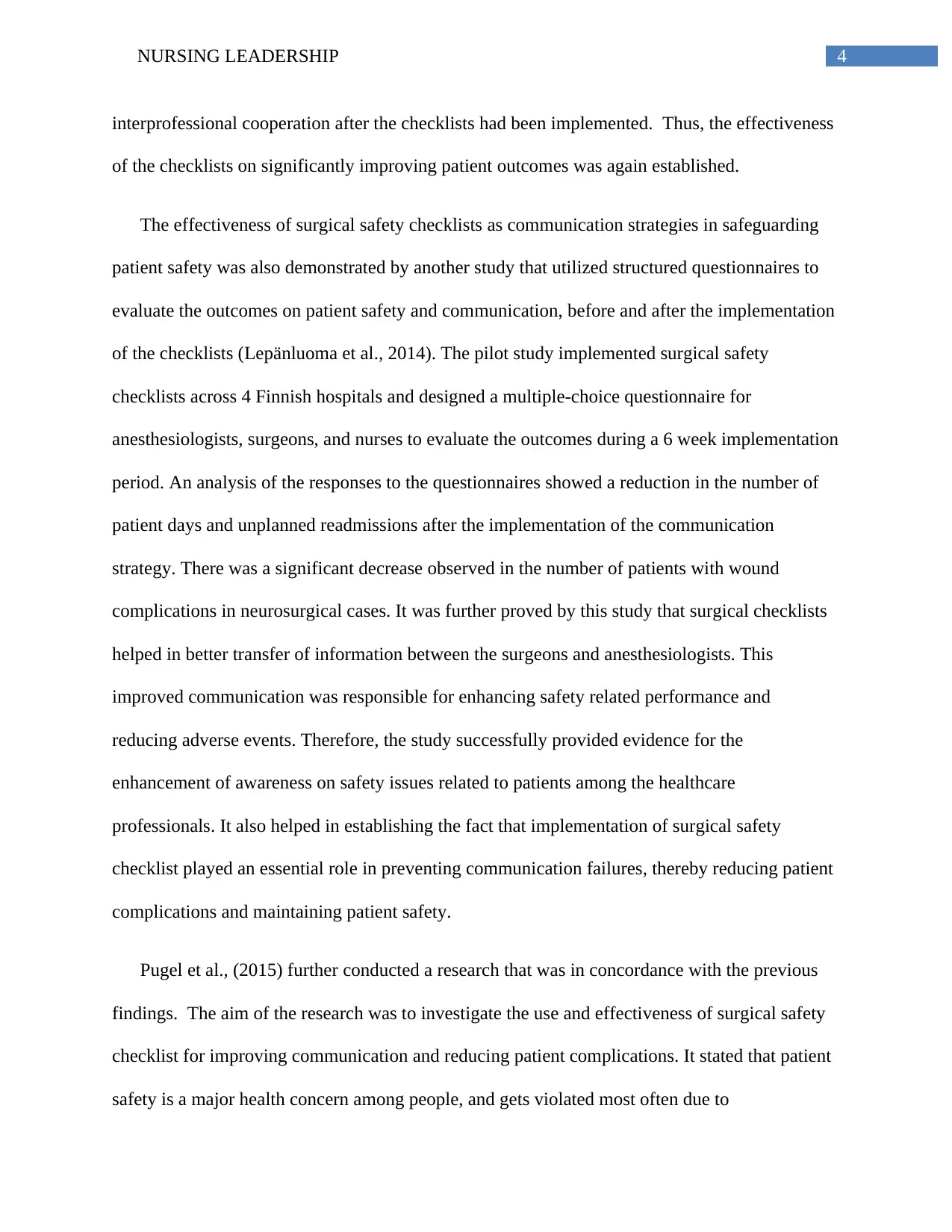
4NURSING LEADERSHIP
interprofessional cooperation after the checklists had been implemented. Thus, the effectiveness
of the checklists on significantly improving patient outcomes was again established.
The effectiveness of surgical safety checklists as communication strategies in safeguarding
patient safety was also demonstrated by another study that utilized structured questionnaires to
evaluate the outcomes on patient safety and communication, before and after the implementation
of the checklists (Lepänluoma et al., 2014). The pilot study implemented surgical safety
checklists across 4 Finnish hospitals and designed a multiple-choice questionnaire for
anesthesiologists, surgeons, and nurses to evaluate the outcomes during a 6 week implementation
period. An analysis of the responses to the questionnaires showed a reduction in the number of
patient days and unplanned readmissions after the implementation of the communication
strategy. There was a significant decrease observed in the number of patients with wound
complications in neurosurgical cases. It was further proved by this study that surgical checklists
helped in better transfer of information between the surgeons and anesthesiologists. This
improved communication was responsible for enhancing safety related performance and
reducing adverse events. Therefore, the study successfully provided evidence for the
enhancement of awareness on safety issues related to patients among the healthcare
professionals. It also helped in establishing the fact that implementation of surgical safety
checklist played an essential role in preventing communication failures, thereby reducing patient
complications and maintaining patient safety.
Pugel et al., (2015) further conducted a research that was in concordance with the previous
findings. The aim of the research was to investigate the use and effectiveness of surgical safety
checklist for improving communication and reducing patient complications. It stated that patient
safety is a major health concern among people, and gets violated most often due to
interprofessional cooperation after the checklists had been implemented. Thus, the effectiveness
of the checklists on significantly improving patient outcomes was again established.
The effectiveness of surgical safety checklists as communication strategies in safeguarding
patient safety was also demonstrated by another study that utilized structured questionnaires to
evaluate the outcomes on patient safety and communication, before and after the implementation
of the checklists (Lepänluoma et al., 2014). The pilot study implemented surgical safety
checklists across 4 Finnish hospitals and designed a multiple-choice questionnaire for
anesthesiologists, surgeons, and nurses to evaluate the outcomes during a 6 week implementation
period. An analysis of the responses to the questionnaires showed a reduction in the number of
patient days and unplanned readmissions after the implementation of the communication
strategy. There was a significant decrease observed in the number of patients with wound
complications in neurosurgical cases. It was further proved by this study that surgical checklists
helped in better transfer of information between the surgeons and anesthesiologists. This
improved communication was responsible for enhancing safety related performance and
reducing adverse events. Therefore, the study successfully provided evidence for the
enhancement of awareness on safety issues related to patients among the healthcare
professionals. It also helped in establishing the fact that implementation of surgical safety
checklist played an essential role in preventing communication failures, thereby reducing patient
complications and maintaining patient safety.
Pugel et al., (2015) further conducted a research that was in concordance with the previous
findings. The aim of the research was to investigate the use and effectiveness of surgical safety
checklist for improving communication and reducing patient complications. It stated that patient
safety is a major health concern among people, and gets violated most often due to

5NURSING LEADERSHIP
communication lapses. Owing to the fact that the healthcare professionals are interdependent on
each other, there is a need to communicate effectively in order to promote teamwork. It further
showed that communication failures were a common phenomenon and affected patient safety. In
addition, it provided evidence that suggested a decline by more than 50% in miscommunication
events on surgical briefing. Furthermore, the results also suggested that checklists were essential
for maintaining patient safety as they created provisions for the healthcare staff to voice their
concerns for the respective patients, while sharing critical patient information. This helped in
formulating a proper patient care plan and improving patient outcomes.
A team at the Broward Health Imperial Point Hospital, Ft Lauderdale, Florida tried to
improve team communication by implementing a program that focused on the WHO proposed
surgical safety checklist (Cabral et al., 2016). A safety attributes questionnaires was used as the
measurement tool and helped to evaluate the attitudes of the caregivers on safety climate,
perceptions, and team communication. Analysis of the responses using the SPSS 23 software
package displayed highest internal consistency for communication among team members, which
in turn improved the safety climate. Maximum increase in communication was observed among
nurses upon implementation of the tool. Thus, the checklist tool significantly affected the
perceptions of the surgical team on communication. However, the major limitations were
associated with the small sample size and anonymity of each sample. The fact that sharing
critical information related to patient health via the implementation of surgical checklist fosters
team communication and improves patient safety was again supported by another research.
It suggested that communication errors contributed to adverse health outcomes among
patients. Failure to make adequate information reach the correct persons often gave rise to
critical issues. This resulted in mistakes in an operation theatre and also contributed to
communication lapses. Owing to the fact that the healthcare professionals are interdependent on
each other, there is a need to communicate effectively in order to promote teamwork. It further
showed that communication failures were a common phenomenon and affected patient safety. In
addition, it provided evidence that suggested a decline by more than 50% in miscommunication
events on surgical briefing. Furthermore, the results also suggested that checklists were essential
for maintaining patient safety as they created provisions for the healthcare staff to voice their
concerns for the respective patients, while sharing critical patient information. This helped in
formulating a proper patient care plan and improving patient outcomes.
A team at the Broward Health Imperial Point Hospital, Ft Lauderdale, Florida tried to
improve team communication by implementing a program that focused on the WHO proposed
surgical safety checklist (Cabral et al., 2016). A safety attributes questionnaires was used as the
measurement tool and helped to evaluate the attitudes of the caregivers on safety climate,
perceptions, and team communication. Analysis of the responses using the SPSS 23 software
package displayed highest internal consistency for communication among team members, which
in turn improved the safety climate. Maximum increase in communication was observed among
nurses upon implementation of the tool. Thus, the checklist tool significantly affected the
perceptions of the surgical team on communication. However, the major limitations were
associated with the small sample size and anonymity of each sample. The fact that sharing
critical information related to patient health via the implementation of surgical checklist fosters
team communication and improves patient safety was again supported by another research.
It suggested that communication errors contributed to adverse health outcomes among
patients. Failure to make adequate information reach the correct persons often gave rise to
critical issues. This resulted in mistakes in an operation theatre and also contributed to
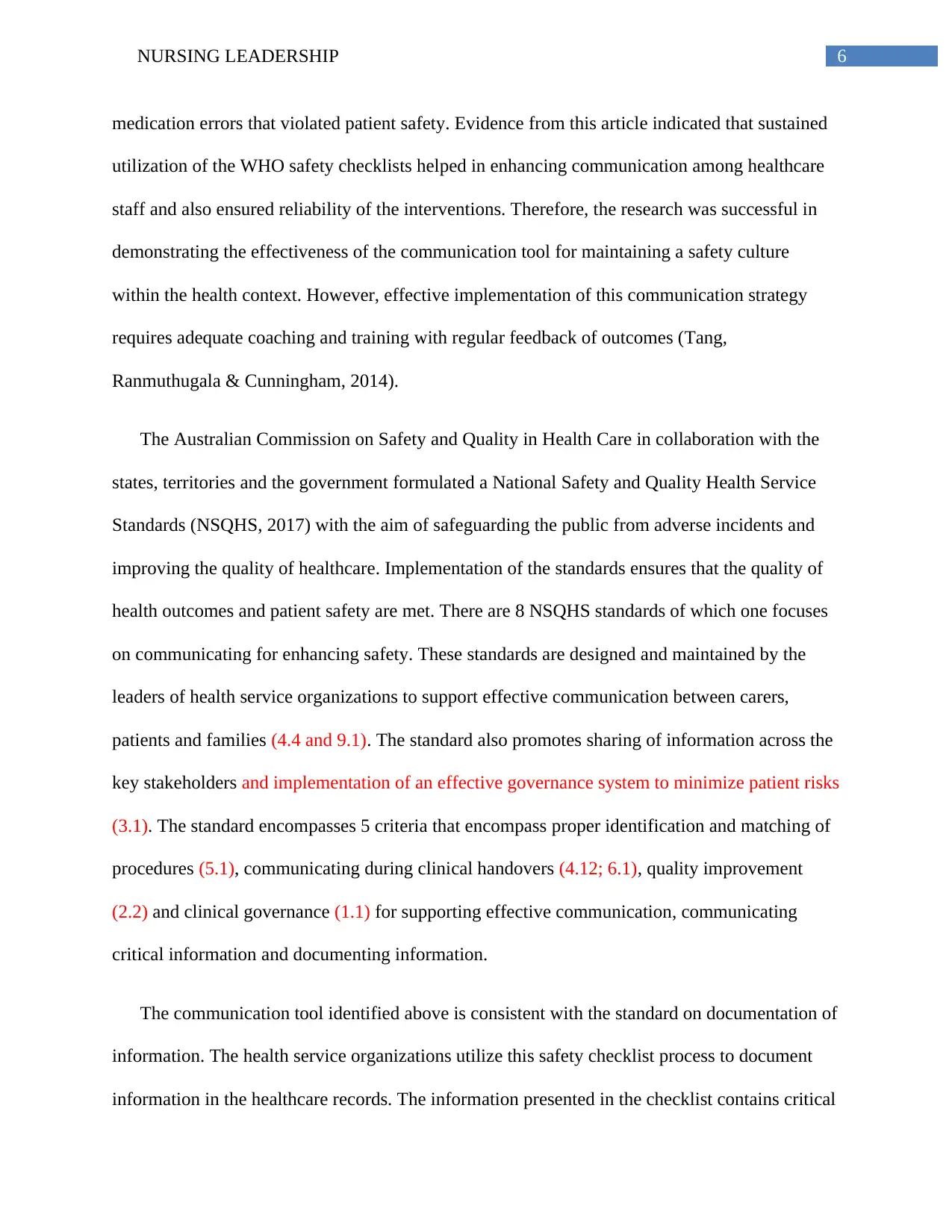
6NURSING LEADERSHIP
medication errors that violated patient safety. Evidence from this article indicated that sustained
utilization of the WHO safety checklists helped in enhancing communication among healthcare
staff and also ensured reliability of the interventions. Therefore, the research was successful in
demonstrating the effectiveness of the communication tool for maintaining a safety culture
within the health context. However, effective implementation of this communication strategy
requires adequate coaching and training with regular feedback of outcomes (Tang,
Ranmuthugala & Cunningham, 2014).
The Australian Commission on Safety and Quality in Health Care in collaboration with the
states, territories and the government formulated a National Safety and Quality Health Service
Standards (NSQHS, 2017) with the aim of safeguarding the public from adverse incidents and
improving the quality of healthcare. Implementation of the standards ensures that the quality of
health outcomes and patient safety are met. There are 8 NSQHS standards of which one focuses
on communicating for enhancing safety. These standards are designed and maintained by the
leaders of health service organizations to support effective communication between carers,
patients and families (4.4 and 9.1). The standard also promotes sharing of information across the
key stakeholders and implementation of an effective governance system to minimize patient risks
(3.1). The standard encompasses 5 criteria that encompass proper identification and matching of
procedures (5.1), communicating during clinical handovers (4.12; 6.1), quality improvement
(2.2) and clinical governance (1.1) for supporting effective communication, communicating
critical information and documenting information.
The communication tool identified above is consistent with the standard on documentation of
information. The health service organizations utilize this safety checklist process to document
information in the healthcare records. The information presented in the checklist contains critical
medication errors that violated patient safety. Evidence from this article indicated that sustained
utilization of the WHO safety checklists helped in enhancing communication among healthcare
staff and also ensured reliability of the interventions. Therefore, the research was successful in
demonstrating the effectiveness of the communication tool for maintaining a safety culture
within the health context. However, effective implementation of this communication strategy
requires adequate coaching and training with regular feedback of outcomes (Tang,
Ranmuthugala & Cunningham, 2014).
The Australian Commission on Safety and Quality in Health Care in collaboration with the
states, territories and the government formulated a National Safety and Quality Health Service
Standards (NSQHS, 2017) with the aim of safeguarding the public from adverse incidents and
improving the quality of healthcare. Implementation of the standards ensures that the quality of
health outcomes and patient safety are met. There are 8 NSQHS standards of which one focuses
on communicating for enhancing safety. These standards are designed and maintained by the
leaders of health service organizations to support effective communication between carers,
patients and families (4.4 and 9.1). The standard also promotes sharing of information across the
key stakeholders and implementation of an effective governance system to minimize patient risks
(3.1). The standard encompasses 5 criteria that encompass proper identification and matching of
procedures (5.1), communicating during clinical handovers (4.12; 6.1), quality improvement
(2.2) and clinical governance (1.1) for supporting effective communication, communicating
critical information and documenting information.
The communication tool identified above is consistent with the standard on documentation of
information. The health service organizations utilize this safety checklist process to document
information in the healthcare records. The information presented in the checklist contains critical
Secure Best Marks with AI Grader
Need help grading? Try our AI Grader for instant feedback on your assignments.

7NURSING LEADERSHIP
information on the risks and alerts associated with particular patients. This checklist matches the
criteria of the standard in that it strengthens the commitment shown by clinical staff while
addressing safety of patients within surgical settings. Miscommunication often leads to errors in
patient’s medication upon admission or during hospital stays. Such medication errors
significantly contribute to death across healthcare settings. The safety checklists contain
information on the confirmation of patient identity, marking of surgical site, complete check of
medication and anesthesia machine, and previous history of allergy, blood loss or aspiration risks
that need to be read out loud before inducing anesthesia (Bliss et al., 2012). The checklists also
make it necessary to document information on the effectiveness of the team members of
introducing themselves, verbal confirmation from the surgeons, anesthetists and registered
practitioners, and anticipated critical events. Therefore, documenting all such critical information
related to the role of healthcare professionals and the health status of the patients involved helps
in enhancing communication between the staff, thereby improving patient safety (Aveling,
McCulloch & Dixon-Woods, 2013). Thus, positive health outcomes are obtained, the rates of
medication errors are reduced and the rates of mortality and morbidity are significantly lowered.
Nurses play a critical role in quality improvement. They are responsible for measuring,
improving and controlling the factors that may affect patient outcomes. In addition, they are also
involved in carrying out interdisciplinary processes that will help them meet the goals of the
healthcare organizations. With the aim of quality improvement, the nurses participate in all
aspects of patient care, medication management, surgery assistance, collection and reporting of
data and sharing critical patient information with other team members. They are also imperative
for educating the patients and their family members on the risk factors that may contribute to
adverse health effects (Cullati et al., 2014). An ever increasing demand is observed for quality
information on the risks and alerts associated with particular patients. This checklist matches the
criteria of the standard in that it strengthens the commitment shown by clinical staff while
addressing safety of patients within surgical settings. Miscommunication often leads to errors in
patient’s medication upon admission or during hospital stays. Such medication errors
significantly contribute to death across healthcare settings. The safety checklists contain
information on the confirmation of patient identity, marking of surgical site, complete check of
medication and anesthesia machine, and previous history of allergy, blood loss or aspiration risks
that need to be read out loud before inducing anesthesia (Bliss et al., 2012). The checklists also
make it necessary to document information on the effectiveness of the team members of
introducing themselves, verbal confirmation from the surgeons, anesthetists and registered
practitioners, and anticipated critical events. Therefore, documenting all such critical information
related to the role of healthcare professionals and the health status of the patients involved helps
in enhancing communication between the staff, thereby improving patient safety (Aveling,
McCulloch & Dixon-Woods, 2013). Thus, positive health outcomes are obtained, the rates of
medication errors are reduced and the rates of mortality and morbidity are significantly lowered.
Nurses play a critical role in quality improvement. They are responsible for measuring,
improving and controlling the factors that may affect patient outcomes. In addition, they are also
involved in carrying out interdisciplinary processes that will help them meet the goals of the
healthcare organizations. With the aim of quality improvement, the nurses participate in all
aspects of patient care, medication management, surgery assistance, collection and reporting of
data and sharing critical patient information with other team members. They are also imperative
for educating the patients and their family members on the risk factors that may contribute to
adverse health effects (Cullati et al., 2014). An ever increasing demand is observed for quality

8NURSING LEADERSHIP
improvement across all hospitals due to the presence of hospital organizations, accreditation or
regulatory boards, federal government mandates, medical societies, health insurance plans and
non-profit organizations (NGOs).
Therefore, the nurses must re-structure the hospital setting in order to undertake constructive
actions that will help in safeguarding the patients. Clinical leadership qualities also make it
mandatory for nurses to develop skills and knowledge that influence management changes
(Tillman et al., 2013). They are expected to participate in the lead change management processes
that will help them in identifying the gaps in the healthcare setting and devising strategies.
There are different barriers that may prevent the implementation of surgical safety checklists
as effective communication strategy. Organizational barriers are associated to lack of training or
education, no customization of practices according to patient demands, hospital culture,
resistance to changes, and lack of support from hospital management (Hurtado et al., 2012).
Checklist specific barriers include the structure or layout and content of the checklist, late time-
outs, inappropriate documentation for surgical specialties and reaction of the concerned patients
towards the checklists. Team barriers encompass noncompliance or resistance from senior nurses
and surgeons for checklist implementation (Rydenfält et al., 2013). System barriers refer to the
long time that is taken to document all information in the checklist and repetitions of existing
safety practices.
There are certain facilitators for the implementation of this communication tool.
Organizational facilitator focuses on creating provisions for education and training of the staff,
conducting regular feedback sessions on the benefits of checklists, penalizing employees who
exhibit noncompliance and gathering visible support from the management (Russ et al., 2015).
improvement across all hospitals due to the presence of hospital organizations, accreditation or
regulatory boards, federal government mandates, medical societies, health insurance plans and
non-profit organizations (NGOs).
Therefore, the nurses must re-structure the hospital setting in order to undertake constructive
actions that will help in safeguarding the patients. Clinical leadership qualities also make it
mandatory for nurses to develop skills and knowledge that influence management changes
(Tillman et al., 2013). They are expected to participate in the lead change management processes
that will help them in identifying the gaps in the healthcare setting and devising strategies.
There are different barriers that may prevent the implementation of surgical safety checklists
as effective communication strategy. Organizational barriers are associated to lack of training or
education, no customization of practices according to patient demands, hospital culture,
resistance to changes, and lack of support from hospital management (Hurtado et al., 2012).
Checklist specific barriers include the structure or layout and content of the checklist, late time-
outs, inappropriate documentation for surgical specialties and reaction of the concerned patients
towards the checklists. Team barriers encompass noncompliance or resistance from senior nurses
and surgeons for checklist implementation (Rydenfält et al., 2013). System barriers refer to the
long time that is taken to document all information in the checklist and repetitions of existing
safety practices.
There are certain facilitators for the implementation of this communication tool.
Organizational facilitator focuses on creating provisions for education and training of the staff,
conducting regular feedback sessions on the benefits of checklists, penalizing employees who
exhibit noncompliance and gathering visible support from the management (Russ et al., 2015).
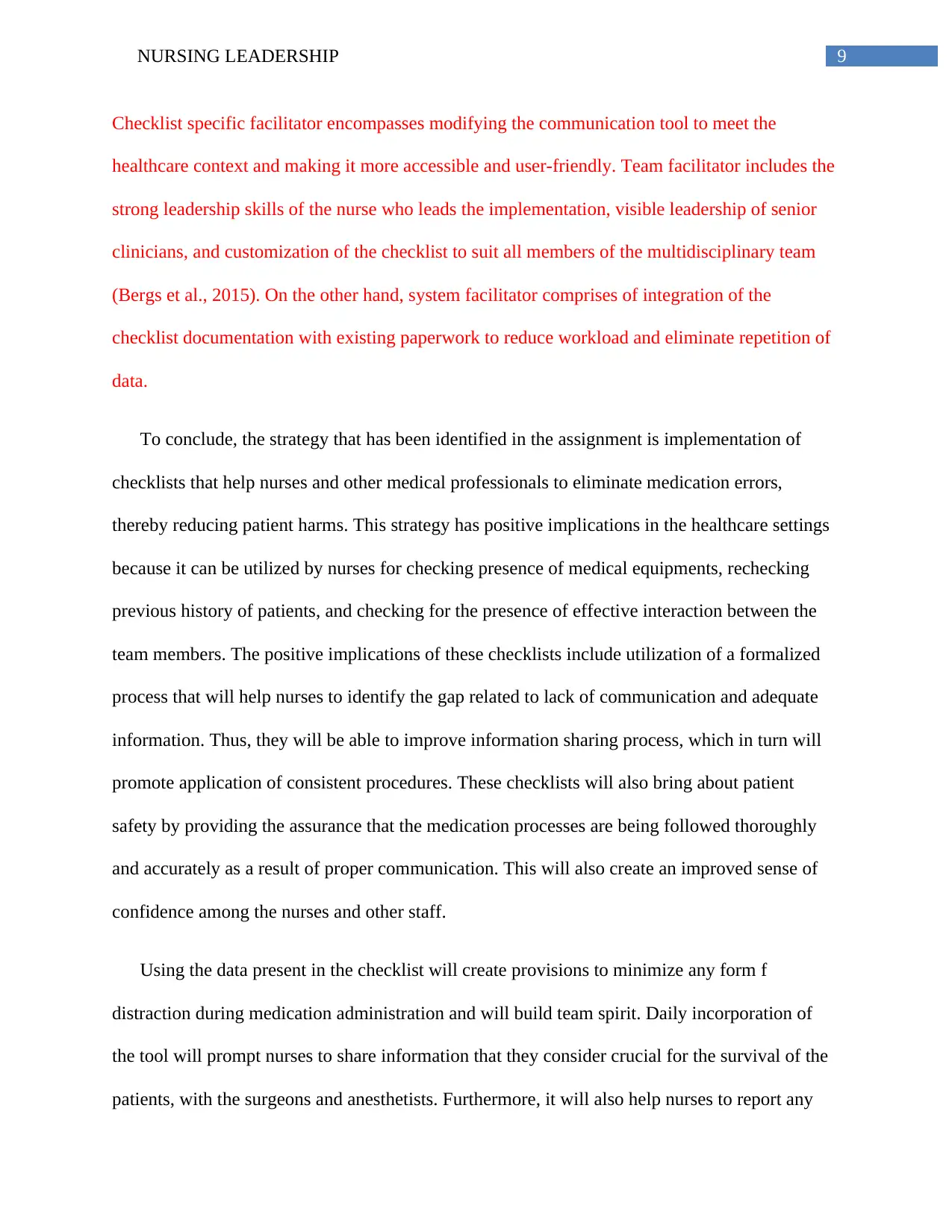
9NURSING LEADERSHIP
Checklist specific facilitator encompasses modifying the communication tool to meet the
healthcare context and making it more accessible and user-friendly. Team facilitator includes the
strong leadership skills of the nurse who leads the implementation, visible leadership of senior
clinicians, and customization of the checklist to suit all members of the multidisciplinary team
(Bergs et al., 2015). On the other hand, system facilitator comprises of integration of the
checklist documentation with existing paperwork to reduce workload and eliminate repetition of
data.
To conclude, the strategy that has been identified in the assignment is implementation of
checklists that help nurses and other medical professionals to eliminate medication errors,
thereby reducing patient harms. This strategy has positive implications in the healthcare settings
because it can be utilized by nurses for checking presence of medical equipments, rechecking
previous history of patients, and checking for the presence of effective interaction between the
team members. The positive implications of these checklists include utilization of a formalized
process that will help nurses to identify the gap related to lack of communication and adequate
information. Thus, they will be able to improve information sharing process, which in turn will
promote application of consistent procedures. These checklists will also bring about patient
safety by providing the assurance that the medication processes are being followed thoroughly
and accurately as a result of proper communication. This will also create an improved sense of
confidence among the nurses and other staff.
Using the data present in the checklist will create provisions to minimize any form f
distraction during medication administration and will build team spirit. Daily incorporation of
the tool will prompt nurses to share information that they consider crucial for the survival of the
patients, with the surgeons and anesthetists. Furthermore, it will also help nurses to report any
Checklist specific facilitator encompasses modifying the communication tool to meet the
healthcare context and making it more accessible and user-friendly. Team facilitator includes the
strong leadership skills of the nurse who leads the implementation, visible leadership of senior
clinicians, and customization of the checklist to suit all members of the multidisciplinary team
(Bergs et al., 2015). On the other hand, system facilitator comprises of integration of the
checklist documentation with existing paperwork to reduce workload and eliminate repetition of
data.
To conclude, the strategy that has been identified in the assignment is implementation of
checklists that help nurses and other medical professionals to eliminate medication errors,
thereby reducing patient harms. This strategy has positive implications in the healthcare settings
because it can be utilized by nurses for checking presence of medical equipments, rechecking
previous history of patients, and checking for the presence of effective interaction between the
team members. The positive implications of these checklists include utilization of a formalized
process that will help nurses to identify the gap related to lack of communication and adequate
information. Thus, they will be able to improve information sharing process, which in turn will
promote application of consistent procedures. These checklists will also bring about patient
safety by providing the assurance that the medication processes are being followed thoroughly
and accurately as a result of proper communication. This will also create an improved sense of
confidence among the nurses and other staff.
Using the data present in the checklist will create provisions to minimize any form f
distraction during medication administration and will build team spirit. Daily incorporation of
the tool will prompt nurses to share information that they consider crucial for the survival of the
patients, with the surgeons and anesthetists. Furthermore, it will also help nurses to report any
Paraphrase This Document
Need a fresh take? Get an instant paraphrase of this document with our AI Paraphraser
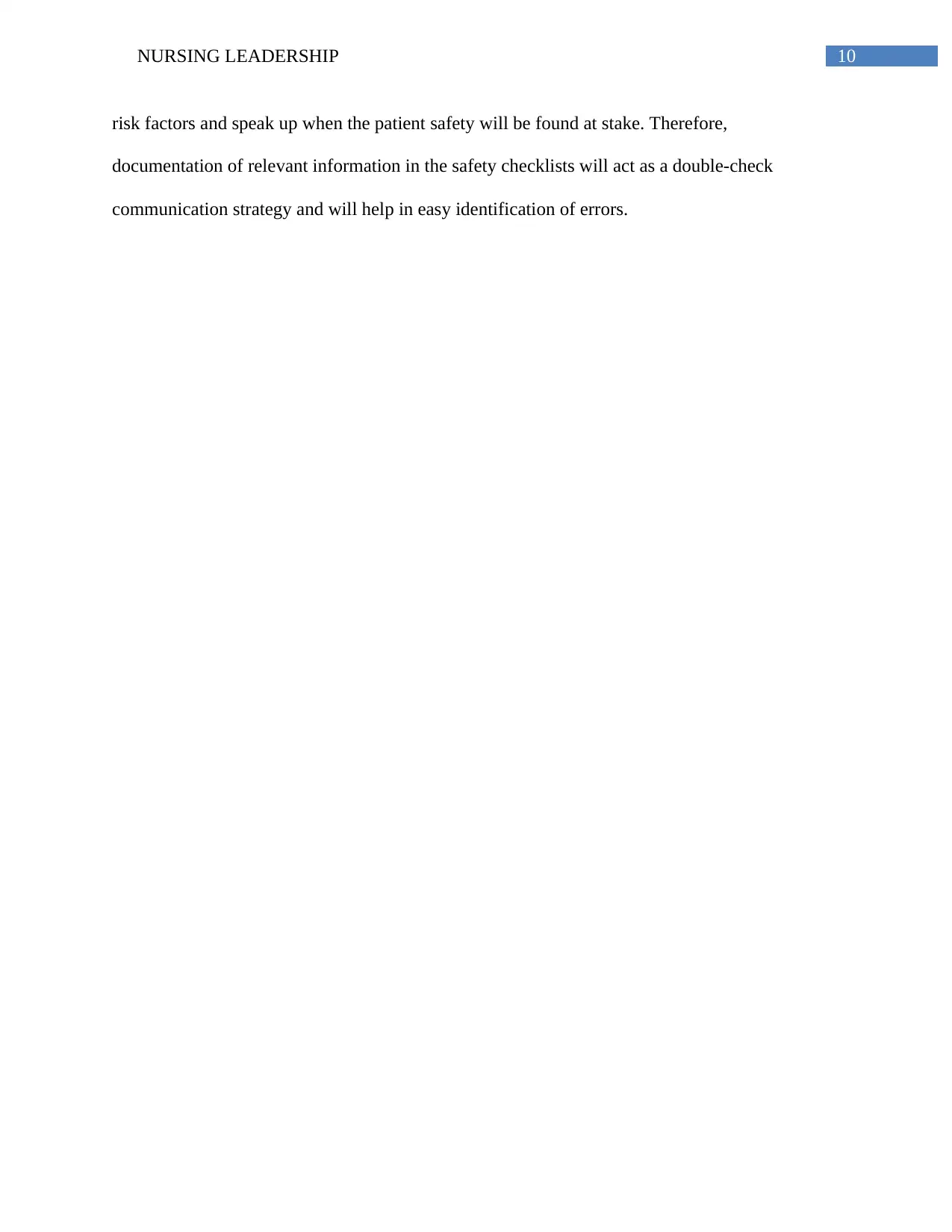
10NURSING LEADERSHIP
risk factors and speak up when the patient safety will be found at stake. Therefore,
documentation of relevant information in the safety checklists will act as a double-check
communication strategy and will help in easy identification of errors.
risk factors and speak up when the patient safety will be found at stake. Therefore,
documentation of relevant information in the safety checklists will act as a double-check
communication strategy and will help in easy identification of errors.
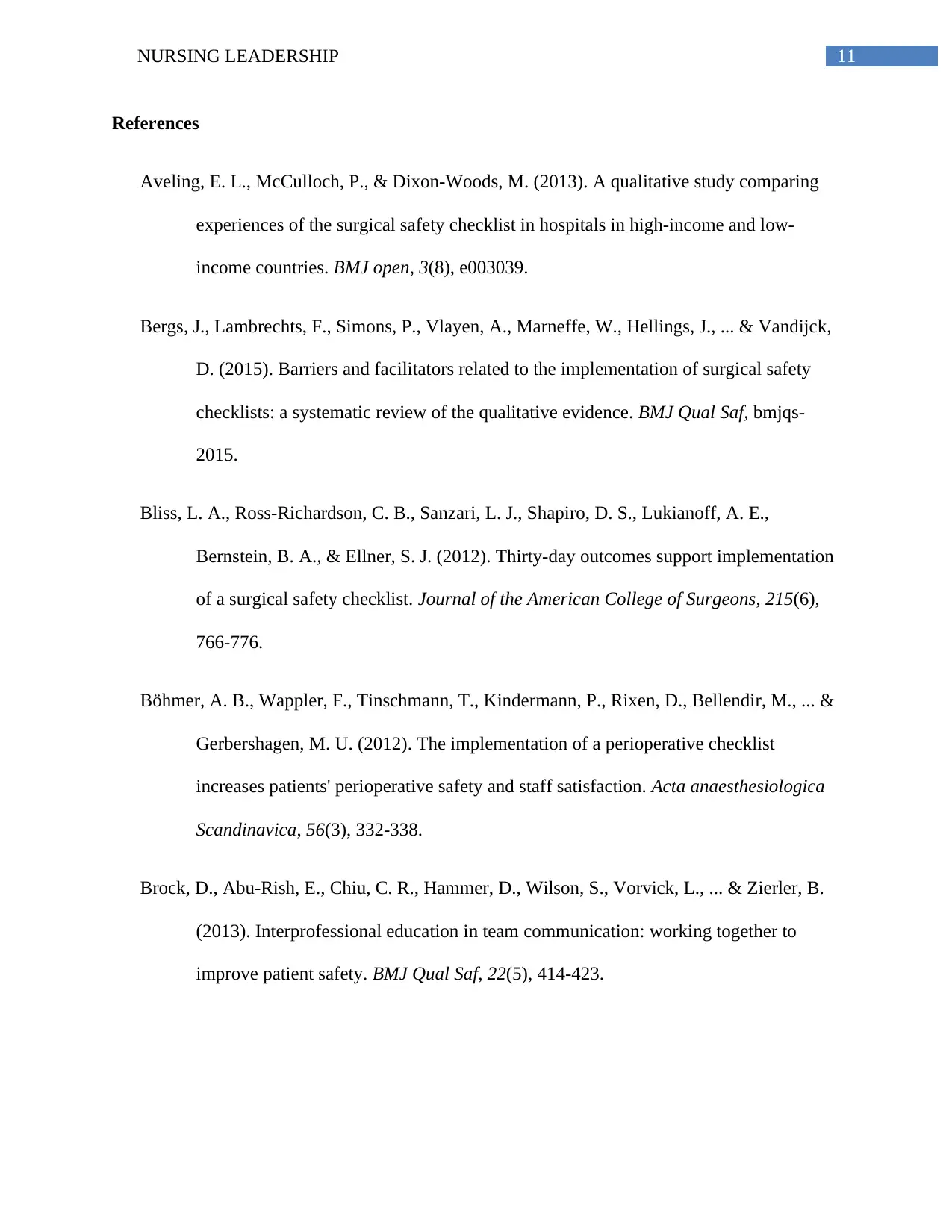
11NURSING LEADERSHIP
References
Aveling, E. L., McCulloch, P., & Dixon-Woods, M. (2013). A qualitative study comparing
experiences of the surgical safety checklist in hospitals in high-income and low-
income countries. BMJ open, 3(8), e003039.
Bergs, J., Lambrechts, F., Simons, P., Vlayen, A., Marneffe, W., Hellings, J., ... & Vandijck,
D. (2015). Barriers and facilitators related to the implementation of surgical safety
checklists: a systematic review of the qualitative evidence. BMJ Qual Saf, bmjqs-
2015.
Bliss, L. A., Ross-Richardson, C. B., Sanzari, L. J., Shapiro, D. S., Lukianoff, A. E.,
Bernstein, B. A., & Ellner, S. J. (2012). Thirty-day outcomes support implementation
of a surgical safety checklist. Journal of the American College of Surgeons, 215(6),
766-776.
Böhmer, A. B., Wappler, F., Tinschmann, T., Kindermann, P., Rixen, D., Bellendir, M., ... &
Gerbershagen, M. U. (2012). The implementation of a perioperative checklist
increases patients' perioperative safety and staff satisfaction. Acta anaesthesiologica
Scandinavica, 56(3), 332-338.
Brock, D., Abu-Rish, E., Chiu, C. R., Hammer, D., Wilson, S., Vorvick, L., ... & Zierler, B.
(2013). Interprofessional education in team communication: working together to
improve patient safety. BMJ Qual Saf, 22(5), 414-423.
References
Aveling, E. L., McCulloch, P., & Dixon-Woods, M. (2013). A qualitative study comparing
experiences of the surgical safety checklist in hospitals in high-income and low-
income countries. BMJ open, 3(8), e003039.
Bergs, J., Lambrechts, F., Simons, P., Vlayen, A., Marneffe, W., Hellings, J., ... & Vandijck,
D. (2015). Barriers and facilitators related to the implementation of surgical safety
checklists: a systematic review of the qualitative evidence. BMJ Qual Saf, bmjqs-
2015.
Bliss, L. A., Ross-Richardson, C. B., Sanzari, L. J., Shapiro, D. S., Lukianoff, A. E.,
Bernstein, B. A., & Ellner, S. J. (2012). Thirty-day outcomes support implementation
of a surgical safety checklist. Journal of the American College of Surgeons, 215(6),
766-776.
Böhmer, A. B., Wappler, F., Tinschmann, T., Kindermann, P., Rixen, D., Bellendir, M., ... &
Gerbershagen, M. U. (2012). The implementation of a perioperative checklist
increases patients' perioperative safety and staff satisfaction. Acta anaesthesiologica
Scandinavica, 56(3), 332-338.
Brock, D., Abu-Rish, E., Chiu, C. R., Hammer, D., Wilson, S., Vorvick, L., ... & Zierler, B.
(2013). Interprofessional education in team communication: working together to
improve patient safety. BMJ Qual Saf, 22(5), 414-423.
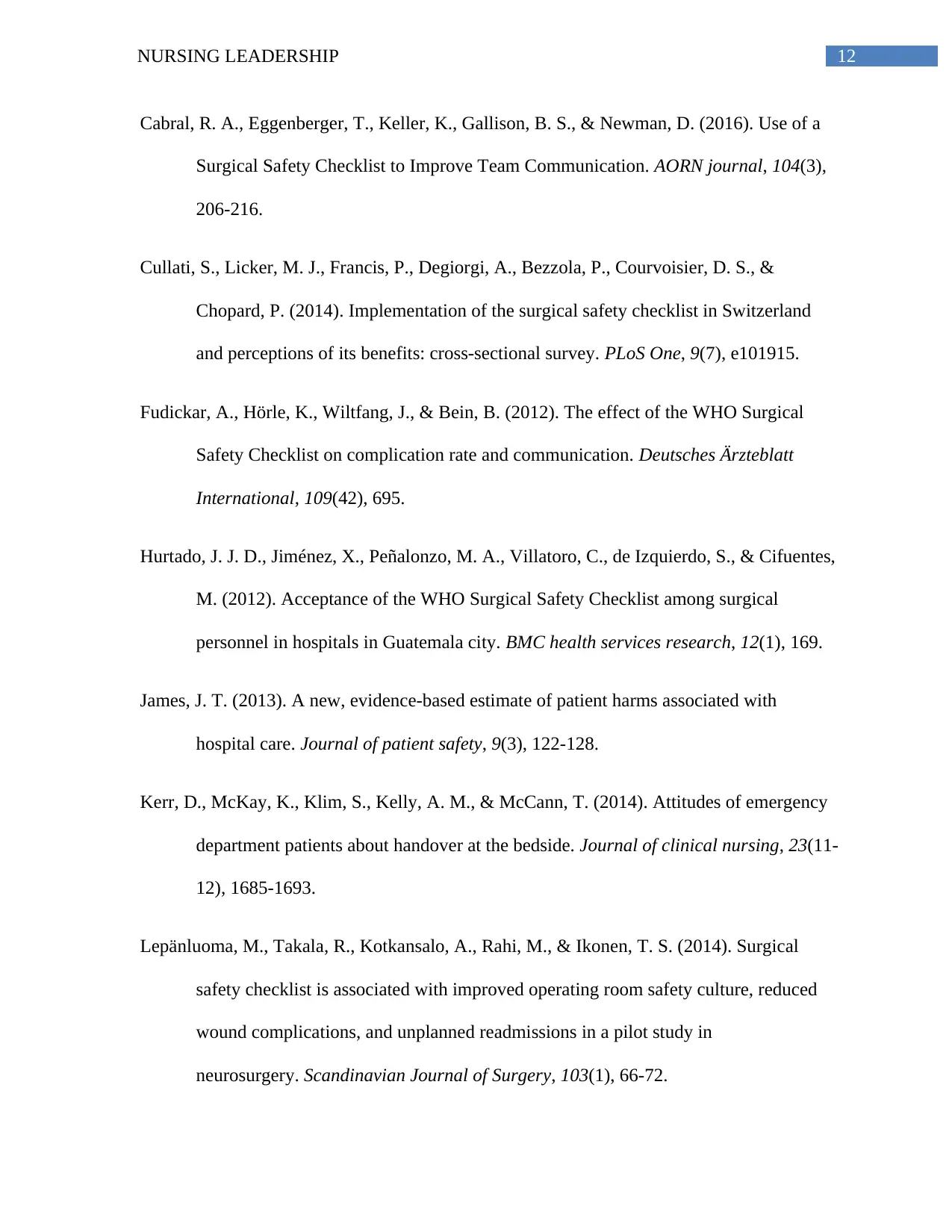
12NURSING LEADERSHIP
Cabral, R. A., Eggenberger, T., Keller, K., Gallison, B. S., & Newman, D. (2016). Use of a
Surgical Safety Checklist to Improve Team Communication. AORN journal, 104(3),
206-216.
Cullati, S., Licker, M. J., Francis, P., Degiorgi, A., Bezzola, P., Courvoisier, D. S., &
Chopard, P. (2014). Implementation of the surgical safety checklist in Switzerland
and perceptions of its benefits: cross-sectional survey. PLoS One, 9(7), e101915.
Fudickar, A., Hörle, K., Wiltfang, J., & Bein, B. (2012). The effect of the WHO Surgical
Safety Checklist on complication rate and communication. Deutsches Ärzteblatt
International, 109(42), 695.
Hurtado, J. J. D., Jiménez, X., Peñalonzo, M. A., Villatoro, C., de Izquierdo, S., & Cifuentes,
M. (2012). Acceptance of the WHO Surgical Safety Checklist among surgical
personnel in hospitals in Guatemala city. BMC health services research, 12(1), 169.
James, J. T. (2013). A new, evidence-based estimate of patient harms associated with
hospital care. Journal of patient safety, 9(3), 122-128.
Kerr, D., McKay, K., Klim, S., Kelly, A. M., & McCann, T. (2014). Attitudes of emergency
department patients about handover at the bedside. Journal of clinical nursing, 23(11-
12), 1685-1693.
Lepänluoma, M., Takala, R., Kotkansalo, A., Rahi, M., & Ikonen, T. S. (2014). Surgical
safety checklist is associated with improved operating room safety culture, reduced
wound complications, and unplanned readmissions in a pilot study in
neurosurgery. Scandinavian Journal of Surgery, 103(1), 66-72.
Cabral, R. A., Eggenberger, T., Keller, K., Gallison, B. S., & Newman, D. (2016). Use of a
Surgical Safety Checklist to Improve Team Communication. AORN journal, 104(3),
206-216.
Cullati, S., Licker, M. J., Francis, P., Degiorgi, A., Bezzola, P., Courvoisier, D. S., &
Chopard, P. (2014). Implementation of the surgical safety checklist in Switzerland
and perceptions of its benefits: cross-sectional survey. PLoS One, 9(7), e101915.
Fudickar, A., Hörle, K., Wiltfang, J., & Bein, B. (2012). The effect of the WHO Surgical
Safety Checklist on complication rate and communication. Deutsches Ärzteblatt
International, 109(42), 695.
Hurtado, J. J. D., Jiménez, X., Peñalonzo, M. A., Villatoro, C., de Izquierdo, S., & Cifuentes,
M. (2012). Acceptance of the WHO Surgical Safety Checklist among surgical
personnel in hospitals in Guatemala city. BMC health services research, 12(1), 169.
James, J. T. (2013). A new, evidence-based estimate of patient harms associated with
hospital care. Journal of patient safety, 9(3), 122-128.
Kerr, D., McKay, K., Klim, S., Kelly, A. M., & McCann, T. (2014). Attitudes of emergency
department patients about handover at the bedside. Journal of clinical nursing, 23(11-
12), 1685-1693.
Lepänluoma, M., Takala, R., Kotkansalo, A., Rahi, M., & Ikonen, T. S. (2014). Surgical
safety checklist is associated with improved operating room safety culture, reduced
wound complications, and unplanned readmissions in a pilot study in
neurosurgery. Scandinavian Journal of Surgery, 103(1), 66-72.
Secure Best Marks with AI Grader
Need help grading? Try our AI Grader for instant feedback on your assignments.
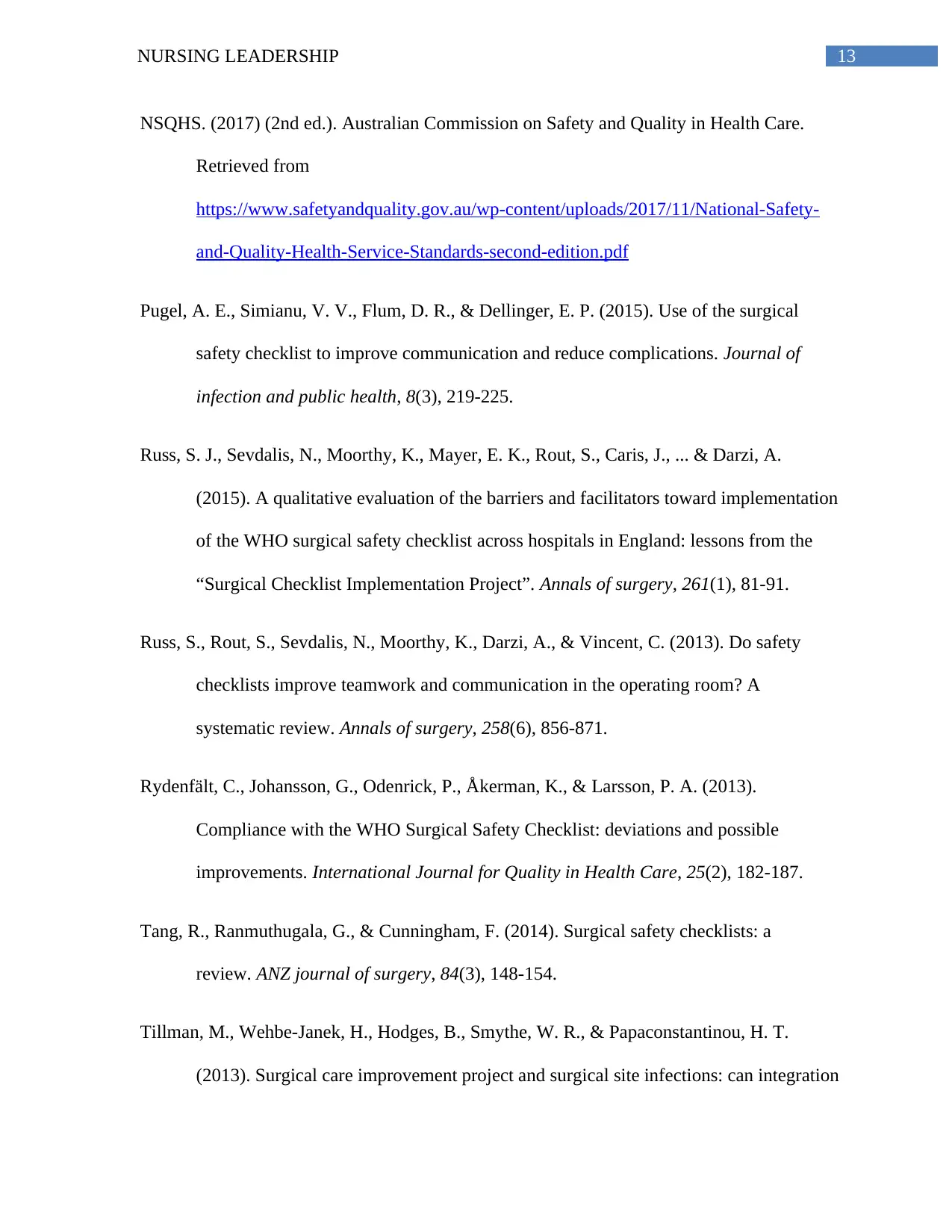
13NURSING LEADERSHIP
NSQHS. (2017) (2nd ed.). Australian Commission on Safety and Quality in Health Care.
Retrieved from
https://www.safetyandquality.gov.au/wp-content/uploads/2017/11/National-Safety-
and-Quality-Health-Service-Standards-second-edition.pdf
Pugel, A. E., Simianu, V. V., Flum, D. R., & Dellinger, E. P. (2015). Use of the surgical
safety checklist to improve communication and reduce complications. Journal of
infection and public health, 8(3), 219-225.
Russ, S. J., Sevdalis, N., Moorthy, K., Mayer, E. K., Rout, S., Caris, J., ... & Darzi, A.
(2015). A qualitative evaluation of the barriers and facilitators toward implementation
of the WHO surgical safety checklist across hospitals in England: lessons from the
“Surgical Checklist Implementation Project”. Annals of surgery, 261(1), 81-91.
Russ, S., Rout, S., Sevdalis, N., Moorthy, K., Darzi, A., & Vincent, C. (2013). Do safety
checklists improve teamwork and communication in the operating room? A
systematic review. Annals of surgery, 258(6), 856-871.
Rydenfält, C., Johansson, G., Odenrick, P., Åkerman, K., & Larsson, P. A. (2013).
Compliance with the WHO Surgical Safety Checklist: deviations and possible
improvements. International Journal for Quality in Health Care, 25(2), 182-187.
Tang, R., Ranmuthugala, G., & Cunningham, F. (2014). Surgical safety checklists: a
review. ANZ journal of surgery, 84(3), 148-154.
Tillman, M., Wehbe-Janek, H., Hodges, B., Smythe, W. R., & Papaconstantinou, H. T.
(2013). Surgical care improvement project and surgical site infections: can integration
NSQHS. (2017) (2nd ed.). Australian Commission on Safety and Quality in Health Care.
Retrieved from
https://www.safetyandquality.gov.au/wp-content/uploads/2017/11/National-Safety-
and-Quality-Health-Service-Standards-second-edition.pdf
Pugel, A. E., Simianu, V. V., Flum, D. R., & Dellinger, E. P. (2015). Use of the surgical
safety checklist to improve communication and reduce complications. Journal of
infection and public health, 8(3), 219-225.
Russ, S. J., Sevdalis, N., Moorthy, K., Mayer, E. K., Rout, S., Caris, J., ... & Darzi, A.
(2015). A qualitative evaluation of the barriers and facilitators toward implementation
of the WHO surgical safety checklist across hospitals in England: lessons from the
“Surgical Checklist Implementation Project”. Annals of surgery, 261(1), 81-91.
Russ, S., Rout, S., Sevdalis, N., Moorthy, K., Darzi, A., & Vincent, C. (2013). Do safety
checklists improve teamwork and communication in the operating room? A
systematic review. Annals of surgery, 258(6), 856-871.
Rydenfält, C., Johansson, G., Odenrick, P., Åkerman, K., & Larsson, P. A. (2013).
Compliance with the WHO Surgical Safety Checklist: deviations and possible
improvements. International Journal for Quality in Health Care, 25(2), 182-187.
Tang, R., Ranmuthugala, G., & Cunningham, F. (2014). Surgical safety checklists: a
review. ANZ journal of surgery, 84(3), 148-154.
Tillman, M., Wehbe-Janek, H., Hodges, B., Smythe, W. R., & Papaconstantinou, H. T.
(2013). Surgical care improvement project and surgical site infections: can integration
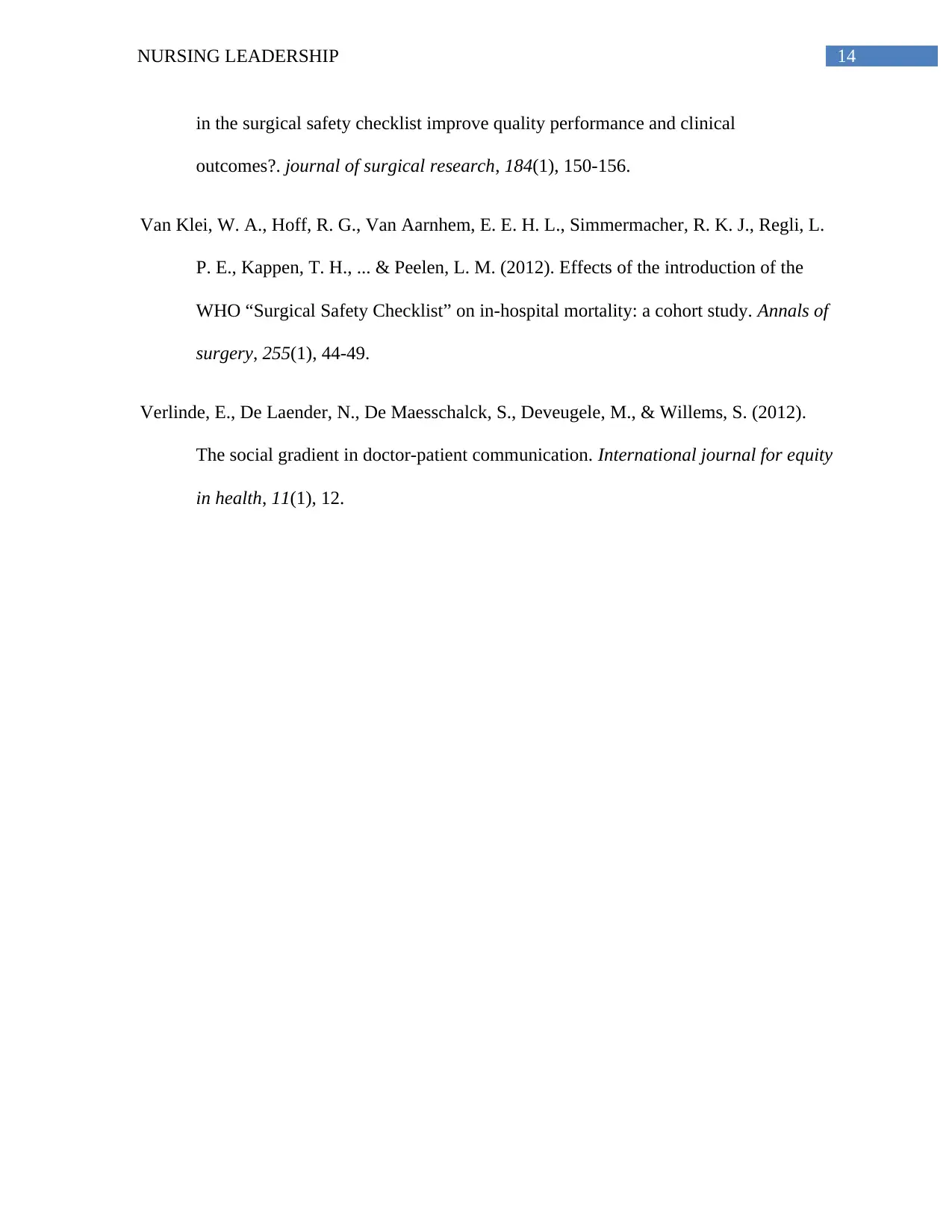
14NURSING LEADERSHIP
in the surgical safety checklist improve quality performance and clinical
outcomes?. journal of surgical research, 184(1), 150-156.
Van Klei, W. A., Hoff, R. G., Van Aarnhem, E. E. H. L., Simmermacher, R. K. J., Regli, L.
P. E., Kappen, T. H., ... & Peelen, L. M. (2012). Effects of the introduction of the
WHO “Surgical Safety Checklist” on in-hospital mortality: a cohort study. Annals of
surgery, 255(1), 44-49.
Verlinde, E., De Laender, N., De Maesschalck, S., Deveugele, M., & Willems, S. (2012).
The social gradient in doctor-patient communication. International journal for equity
in health, 11(1), 12.
in the surgical safety checklist improve quality performance and clinical
outcomes?. journal of surgical research, 184(1), 150-156.
Van Klei, W. A., Hoff, R. G., Van Aarnhem, E. E. H. L., Simmermacher, R. K. J., Regli, L.
P. E., Kappen, T. H., ... & Peelen, L. M. (2012). Effects of the introduction of the
WHO “Surgical Safety Checklist” on in-hospital mortality: a cohort study. Annals of
surgery, 255(1), 44-49.
Verlinde, E., De Laender, N., De Maesschalck, S., Deveugele, M., & Willems, S. (2012).
The social gradient in doctor-patient communication. International journal for equity
in health, 11(1), 12.
1 out of 15
Related Documents
Your All-in-One AI-Powered Toolkit for Academic Success.
+13062052269
info@desklib.com
Available 24*7 on WhatsApp / Email
![[object Object]](/_next/static/media/star-bottom.7253800d.svg)
Unlock your academic potential
© 2024 | Zucol Services PVT LTD | All rights reserved.





